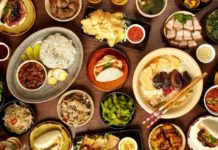Thai cuisine is known for its bold and complex flavors, combining sweet, sour, spicy, salty, and sometimes bitter tastes in a harmonious way. Thai food is often characterized by its use of fresh ingredients, aromatic herbs, and spices that create distinctive and delicious dishes. Here are some key features of Thai cuisine:
- Rice: Rice is a staple food in Thailand, and most Thai meals are served with rice. Jasmine rice, known for its fragrant aroma and soft texture, is the most common type of rice used in Thai cuisine.
- Flavorful Herbs and Spices: Thai cuisine is renowned for its use of aromatic herbs and spices, such as lemongrass, galangal, kaffir lime leaves, Thai basil, cilantro, and Thai chilies. These ingredients add layers of flavors and create the unique taste profiles of Thai dishes.
- Balance of Flavors: Thai cuisine emphasizes a balance of flavors, with dishes typically incorporating sweet, sour, spicy, salty, and sometimes bitter flavors. This balance is achieved through the skillful use of ingredients like palm sugar, lime juice, tamarind paste, fish sauce, and soy sauce.
- Fresh Ingredients: Thai cuisine often relies on fresh and seasonal ingredients, such as vegetables, fruits, seafood, and herbs. Freshness is highly valued in Thai cooking, and many dishes are prepared using freshly pounded spices or herbs for maximum flavor.
- Street Food Culture: Thailand is famous for its vibrant street food culture, with food stalls and markets offering a wide variety of delicious and affordable dishes. Street food is a significant aspect of Thai cuisine, providing an opportunity to sample an array of authentic Thai flavors and dishes.
- Regional Varieties: Thai cuisine varies by region, with each region having its own unique specialties and flavor profiles. For example, the spicy and aromatic flavors of dishes from the northeast (Isan) region differ from the milder and coconut-based flavors of southern Thai cuisine.
- Diverse Dishes: Thai cuisine offers a diverse range of dishes, including curries, stir-fries, soups, salads, noodles, and desserts. Popular Thai dishes include Tom Yum (spicy and sour soup), Pad Thai (stir-fried rice noodles), Green Curry (spicy coconut curry), Som Tum (papaya salad), and Mango Sticky Rice (sweet dessert).
- Condiments and Sauces: Thai cuisine often includes condiments and sauces that are used to enhance the flavors of dishes. These may include fish sauce, soy sauce, oyster sauce, shrimp paste, and chili pastes, among others.
- Food Presentation: Thai cuisine places a strong emphasis on food presentation, with dishes often being visually appealing and aesthetically arranged. Care is taken to create visually stunning dishes that are a treat for the eyes as well as the taste buds.
- Community Dining: In Thai culture, meals are often a communal affair, with multiple dishes being shared among diners. This promotes a sense of togetherness and is a reflection of Thai hospitality and the importance of socializing over food.
Thai cuisine is known for its rich flavors, aromatic herbs, and diverse dishes, making it a beloved culinary tradition that is cherished both within Thailand and internationally.




